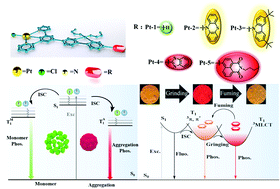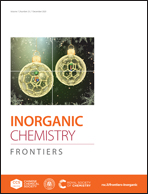AIPE-active Pt(ii) complexes with a tunable triplet excited state: design, mechanochromism and application in anti-counterfeiting†
Abstract
To understand the fundamental mechanism of aggregation-induced phosphorescent emission (AIPE) and to improve the development of mechanochromic molecules, five new Pt(II) complexes Pt-1–Pt-5 bearing different terminal substituents on 1,3-di(2-pyridyl)benzene (N^C^N) ligands were designed and synthesized. Their photophysical properties have been investigated systematically via a series of spectroscopic methods. Upon excitation, the solid states of these Pt complexes exhibit tunable emissions from yellow to red, and complexes Pt-2 and Pt-3 with a large steric hindrance display remarkable AIPE properties in a tetrahydrofuran/H2O mixture. All complexes, except Pt-5, show evident mechanochromic and vapochromic behaviors. Based on in-depth experimental studies, the reason for the mechanochromic behavior could be the change in the distance of the neighboring Pt complexes, which causes a switching of the emission state from 3π,π*/3MLCT (metal-to-ligand charge transfer) to 3MLCT. The above results suggest an example of phosphorescence tuning by a switching of the triplet excited state in the solid state, and provide a mechanism of mechanochromic behavior. Furthermore, complex Pt-2 was used as an emission ink in the field of advanced anti-counterfeiting.



 Please wait while we load your content...
Please wait while we load your content...